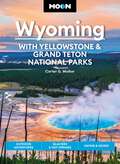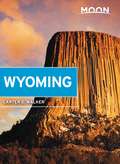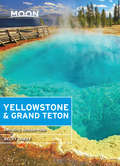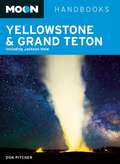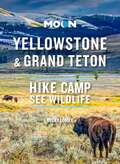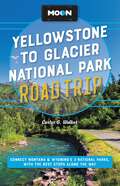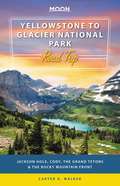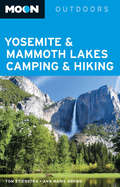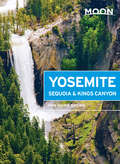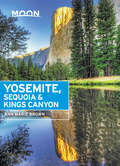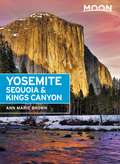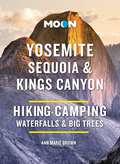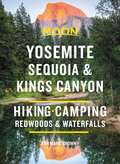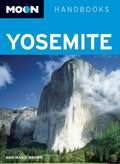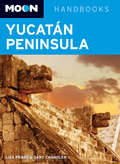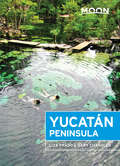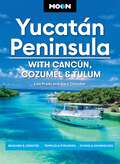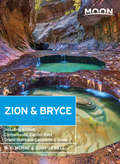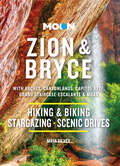- Table View
- List View
Moon Wyoming: Outdoor Adventures, Glaciers & Hot Springs, Hiking & Skiing (Travel Guide)
by Carter G. WalkerFrom sweeping plains and stunning national parks to laidback ski towns and down-home dude ranches, experience the best of the West with Moon Wyoming. Inside you'll find:Strategic, flexible itineraries for history buffs, wildlife enthusiasts, outdoor adventurers, and more, including focused coverage of Yellowstone National Park, Grand Teton National Park, and Devils TowerThe top sights and unique experiences: Learn about Wyoming's indigenous cultures at the Plains Indian Museum or enjoy parades and dancing at a traditional powwow. Immerse yourself in the cowboy lifestyle at a rodeo and explore timeless towns where the Old West is alive and well. Peruse trendy Jackson Hole and dig in to locally raised bison burgers and huckleberry pie Outdoor activities: Hike through Yellowstone's majestic wilderness, spot bison, elk, bears, or wolves, and marvel at the legendary Old Faithful. Go whitewater rafting or kayaking, soak in hot springs, ride a gondola up to jaw-dropping mountain-top views, or ski the alpine slopes at Snow King The best road trips in Wyoming, including a loop through Yellowstone and Grand Teton National Parks Honest advice from former wilderness guide Carter G. Walker on when to go, where to eat, and where to stay, from historic lodges to dude ranches and campsites Full-color photos and detailed maps throughoutThorough background on the history, weather, wildlife, outdoor recreation, safety, and culture With Moon's expert advice and local insight on the best of Wyoming, you can find your adventure. Focusing on the parks? Try Moon Yellowstone & Grand Teton. Exploring the area? Try Moon Montana.About Moon Travel Guides: Moon was founded in 1973 to empower independent, active, and conscious travel. We prioritize local businesses, outdoor recreation, and traveling strategically and sustainably. Moon Travel Guides are written by local, expert authors with great stories to tell—and they can't wait to share their favorite places with you. For more inspiration, follow @moonguides on social media.
Moon Wyoming: With Yellowstone & Grand Teton National Parks (Travel Guide)
by Carter G. WalkerFrom sweeping plains and stunning national parks to laidback ski towns and down-home dude ranches, experience the best of the west with Moon Wyoming. Inside you'll find:Strategic, flexible itineraries for history buffs, wildlife enthusiasts, outdoor adventurers, and more, including focused coverage of Yellowstone National Park, Grand Teton National Park, and Devils TowerThe top sights and unique experiences: Immerse yourself the cowboy lifestyle at a rodeo and explore timeless towns where the Old West is alive and well. Learn about Wyoming's indigenous cultures at the Plains Indian Museum or enjoy parades and dancing at a traditional powwow. Peruse trendy Jackson Hole and dig in to locally raised bison burgers and huckleberry pieOutdoor activities: Hike through Yellowstone's majestic wilderness, spot bison, elk, bears, or wolves, and marvel at the legendary Old Faithful. Go whitewater rafting or kayaking, soak in hot springs, ride a gondola up to jaw-dropping mountain-top views, or ski the alpine slopes at Snow King The best road trips in Wyoming, including a loop through Yellowstone and Grand Teton National ParksHonest advice from former wilderness guide Carter G. Walker on when to go, where to eat, and where to stay, from historic lodges to dude ranches and campsitesFull-color photos and detailed maps throughoutRecommendations for visitors with disabilities, traveling with kids, and LGBTQ+ travelersThorough background on the history, weather, wildlife, outdoor recreation safety, and cultureWith Moon's expert advice and local insight on the best of Wyoming, you can find your adventure.Focusing on the parks? Try Moon Yellowstone & Grand Teton. Exploring the area? Try Moon Montana.
Moon Yellowstone & Grand Teton
by Becky LomaxJoin writer and avid explorer Becky Lomax for an unforgettable experience. With her unique perspective and advice you can trust, Moon Yellowstone & Grand Teton has everything you need to know to have a more personal and memorable experience.Welcome to he land of fire and ice. Moon Yellowstone & Grand Teton shows you what you need to know to plan the perfect trip for you. Explore the geysers and vivid cauldrons of acid and water created by the supervolcano hidden under the mountainous greenery and alien beauty of Yellowstone National Park, and marvel at the mountainous spires of the Rockies and the glacier-smoothed lakes and canyons of Grand Teton National Park. Along with trip ideas like "One Day in Yellowstone" and "Winter Fun," Lomax includes suggestions for the best places to spot elk, bison, bears, and wolves, and tips on which hikes have the most stunning views.With expertly crafted maps and gorgeous photos, this full-color guidebook gives you the tools you need to have an immersive and unique experience. Moon Yellowstone & Grand Teton includes areas such as: North YellowstoneOld Faithful and West YellowstoneCanyon and Lake CountryNorth Grand TetonSouth Grand TetonJackson HoleFind the Moon guide that best suits your trip! Interested in more of our nations greatest National Parks? Try Moon Yosemite, Sequoia, & Kings Canyon, or Moon Death Valley National Park.Staying in the area? Check out Moon Montana & Wyoming.
Moon Yellowstone & Grand Teton: 2011
by Don PitcherA seasoned travel writer guides readers to an array of remarkable experiences waiting just off the tourist track: torchlit ski parades, chuck wagon dinners, white-water kayaking, Native American art shows, dog sled races, and more. 82 photos. 33 illustrations.
Moon Yellowstone & Grand Teton: 2013
by Don PitcherTravel photographer Don Pitcher reveals the splendors of Yellowstone Park and Grand Teton, from the sought-after vacation town of Jackson and a world-class museum complex in Cody to the gorgeous badlands topography of Old-West Dubois. Don is the essential tour guide, covering itineraries such as Yellowstone in a Day, Five Days in Jackson Hole, and The Seven-Day Grand Loop. Moon Yellowstone and Grand Teton is packed with maps and photographs, and places a special emphasis on leading destinations such as Old Faithful Geyser, Lower Falls of the Yellowstone River, Mammoth Hot Springs, the Snake River, and Jackson Hole. Complete with details on watching wildlife, and including information on activities such as camping, hiking, and horseback riding, Moon Yellowstone and Grand Teton gives travelers the tools they need to create a more personal and memorable experience.
Moon Yellowstone & Grand Teton: Hike, Camp, See Wildlife (Travel Guide)
by Becky LomaxForge your way through forests, across mountain peaks, past geysers, and more with Moon Yellowstone & Grand Teton. Inside you'll find:Flexible Itineraries: Adventure-packed ideas ranging from one day in each national park to a week-long road trip covering bothThe Best Hikes in Yellowstone & Grand Teton: Detailed descriptions, individual trail maps, mileage and elevation gains, and backpacking optionsExperience the Outdoors: Marvel at the steam-spewing Old Faithful geyser or take a horseback ride to panoramic lakeside views. Hike through alpine forests to rushing waterfalls and catch a glimpse of wild bison, elk, wolves, or bears. Bask in the colorful radiance of Grand Prismatic Spring or stroll the boardwalks along Mammoth Hot Springs. Climb to Inspiration Point for breathtaking views of Jackson Hole and Jenny Lake, explore the quirky nearby towns, or discover the best spots to hit the slopes during the winter seasonHow to Get There: Up-to-date information on gateway towns, park entrances, park fees, and toursWhere to Stay: Campgrounds, resorts, and more both inside and outside the parkPlanning Tips: When to go, what to pack, safety information, and how to avoid the crowds, with full-color photos and detailed maps throughoutExpertise and Know-How: Explore both national parks with outdoors expert and former park guide Becky Lomax Helpful background on the indigenous culture, landscape, plants and animals, and history of the regionFind your adventure in Yellowstone & Grand Teton National Parks with Moon.Visiting more of North America's national parks? Try Moon Glacier National Park or Moon USA National Parks.
Moon Yellowstone & Grand Teton: Hike, Camp, See Wildlife (Travel Guide)
by Becky LomaxForge your way through forests, across mountain peaks, past geysers, and more with Moon Yellowstone & Grand Teton. Inside you'll find:Flexible Itineraries: Adventure-packed ideas ranging from one day in each national park to a week-long road trip covering both The Best Hikes in Yellowstone & Grand Teton: Detailed descriptions, individual trail maps, mileage and elevation gains, and backpacking options Experience the Outdoors: Marvel at the steam-spewing Old Faithful geyser or take a horseback ride to panoramic lakeside views. Hike through alpine forests to rushing waterfalls and catch a glimpse of wild bison, elk, wolves, or bears. Bask in the colorful radiance of Grand Prismatic Spring or stroll the boardwalks along Mammoth Hot Springs. Climb to Inspiration Point for breathtaking views of Jackson Hole and Jenny Lake, explore the quirky nearby towns, or discover the best spots to hit the slopes during the winter season How to Get There: Up-to-date information on gateway towns, park entrances, park fees, and tours Where to Stay: Campgrounds, resorts, and more both inside and outside the park Planning Tips: When to go, what to pack, safety information, and how to avoid the crowds, with full-color photos and detailed maps throughoutExpertise and Know-How: Explore both national parks with outdoors expert and former park guide Becky Lomax Resources on Covid-19 and traveling to Yellowstone and Grand Teton Helpful background on the indigenous culture, landscape, plants and animals, and history of the region Find your adventure in Yellowstone & Grand Teton National Parks with Moon. Visiting more of North America's national parks? Try Moon Glacier National Park or Moon USA National Parks. About Moon Travel Guides: Moon was founded in 1973 to empower independent, active, and conscious travel. We prioritize local businesses, outdoor recreation, and traveling strategically and sustainably. Moon Travel Guides are written by local, expert authors with great stories to tell—and they can't wait to share their favorite places with you. For more inspiration, follow @moonguides on social media.
Moon Yellowstone & Grand Teton: Hiking, Camping, Wildlife (Moon National Parks Travel Guide)
by Becky Lomax Moon Travel GuidesForge your way through forests, across mountain peaks, past geysers, and more with Moon Yellowstone & Grand Teton. Inside you'll find:Flexible itineraries: Adventure-packed ideas ranging from one day in each national park to a week-long road trip covering both The best hikes in Yellowstone & Grand Teton: Detailed descriptions, mileage and elevation gains, and backpacking options Experience the outdoors: Marvel at the steam-spewing Old Faithful geyser or take a horseback ride to panoramic lakeside views. Hike through alpine forests to rushing waterfalls and catch a glimpse of wild bison, elk, wolves, or bears. Bask in the colorful radiance of Grand Prismatic Spring or stroll the boardwalks along Mammoth Hot Springs. Climb to Inspiration Point for breathtaking views of Jackson Hole and Jenny Lake, explore the quirky nearby towns, or discover the best spots to hit the slopes during the winter season How to get there: Up-to-date information on gateway towns, park entrances, park fees, and tours Where to stay: Campgrounds, resorts, and more both inside and outside the park Planning tips: When to go, what to pack, safety information, and how to avoid the crowds, with full-color photos and detailed maps throughoutExpertise and know-how: Explore both national parks with outdoors expert and former park guide Becky Lomax Helpful background on the indigenous cultures, landscape, plants and animals, and history of the region Find your adventure in Yellowstone & Grand Teton National Parks with Moon. Visiting more of North America's national parks? Try Moon Glacier National Park or Moon USA National Parks. About Moon Travel Guides: Moon was founded in 1973 to empower independent, active, and conscious travel. We prioritize local businesses, outdoor recreation, and traveling strategically and sustainably. Moon Travel Guides are written by local, expert authors with great stories to tell—and they can't wait to share their favorite places with you. For more inspiration, follow @moonguides on social media.
Moon Yellowstone & Grand Teton: Including Jackson Hole (Travel Guide)
by Becky LomaxFind Your Adventure with Moon Travel Guides!Forge your way through forests, across mountain peaks, past geysers, and more with Moon Yellowstone & Grand Teton. Inside you'll find:Itineraries for every timeline, budget, and travel style, ranging from one day in each national park to a week-long road trip covering bothThe top activities and unique ideas for exploring each park: Marvel at the steam-spewing Old Faithful geyser, or take a horseback ride to panoramic lakeside views. Hike through alpine forests to rushing waterfalls, and catch a glimpse of wild bison, elk, wolves, or bears. Climb to Inspiration Point for breathtaking views of Jackson Hole, explore the quirky nearby towns, or discover the best spots to hit the slopes during the winter seasonStrategies for getting to the parks and traveling between them, with suggestions on where to stop along the way to eat, rest, or exploreExpert tips for hiking, backpacking, mountain biking, kayaking, and more, plus essential packing and health and safety informationDetailed hike descriptions with individual trail maps, each marked by duration, elevation change, and moreValuable insight from Yellowstone expert and seasoned explorer Becky LomaxHonest advice on where to stay inside and outside the parks, including campgrounds, cabins, guest ranches, and resortsUp-to-date information on park fees, passes, and reservationsFull-color photos and detailed maps of each national parkCoverage of gateway cities and towns, including Jackson Hole, Big Sky, Red Lodge, Cody, Lander, and DuBoisRecommendations for families, seniors, solo travelers, international visitors, travelers with disabilities, and traveling with petsThorough background on the wildlife, weather, terrain, hazards and personal safety, and history Experience the parks your way with Moon Yellowstone & Grand Teton's practical tips, boundless activities, and reliable expertise.For more of the Rockies, check out Moon Montana & Wyoming, Moon Colorado, or Moon Idaho. Checking out more national parks? Try Moon Glacier National Park.
Moon Yellowstone to Glacier National Park Road Trip: Connect Montana & Wyoming's 3 National Parks, with the Best Stops along the Way (Travel Guide)
by Carter G. WalkerFrom stunning waterfalls, glaciers, and geysers to wide open spaces, answer the call of the wild with Moon Yellowstone to Glacier National Park Road Trip. Inside you'll find:Flexible itineraries: Drive the entire two-week route or explore the region on shorter trips to Glacier, Yellowstone, or Grand Teton Eat, sleep, stop and explore: With lists of the best hikes, views, places for wildlife-watching, and more, you can watch Old Faithful from Observation Point, drive the 50-mile Going-to-the-Sun Road, spot everything from bighorn sheep to bears on a wildlife tour of Yellowstone's Lamar and Hayden valleys, and kick back with a craft beer in Bozeman Outdoor adventures: Hike the trails in Glacier or ski in Whitefish. Admire the reflection of the Grand Tetons as you kayak Jenny Lake or set up camp and stargaze late into the night The best hikes: Detailed descriptions, trail maps, mileage and elevation gains, and backpacking options Maps and driving tools: Easy-to-use maps keep you oriented on and off the highway, along with site-to-site mileage, driving times, detailed directions for the entire route, and full-color photos throughout Local expertise: Former wilderness guide Carter G. Walker shares her deep love of the region Planning your trip: Know when and where to get gas, how to avoid traffic, tips for driving in different road and weather conditions, and suggestions for LGBTQ travelers, seniors, and road-trippers with kids Coverage of Yellowstone, Grand Teton and Glacier National Parks, Bozeman, Jackson Hole, Cody, Whitefish, and more With Moon Yellowstone to Glacier National Park Road Trip's practical tips, flexible itineraries, and local know-how, you're ready to fill up the tank and hit the road. Spending more time in the parks? Check out Moon Glacier National Park or Moon Yellowstone & Grand Teton. Want to extend your adventure? Check out Moon Montana & Wyoming.About Moon Travel Guides: Moon was founded in 1973 to empower independent, active, and conscious travel. We prioritize local businesses, outdoor recreation, and traveling strategically and sustainably. Moon Travel Guides are written by local, expert authors with great stories to tell—and they can't wait to share their favorite places with you. For more inspiration, follow @moonguides on social media.
Moon Yellowstone to Glacier National Park Road Trip: Jackson Hole, the Grand Tetons & the Rocky Mountain Front (Travel Guide)
by Carter G. WalkerFrom stunning waterfalls, glaciers, and geysers to wide open spaces begging to be explored, answer the call of the wild with Moon Yellowstone to Glacier National Park Road Trip. Inside you'll find:Maps and Driving Tools: Easy-to-use maps keep you oriented on and off the highway, along with site-to-site mileage, driving times, detailed directions for the entire route, and full-color photos throughoutEat, Sleep, Stop and Explore: With lists of the best hikes, views, places for wildlife-watching, and more, you can watch Old Faithful from Observation Point, drive the 50-mile Going-to-the-Sun Road, spot everything from bighorn sheep to bears on a wildlife tour of Yellowstone's Lamar and Hayden valleys, and kick back with a craft beer in BozemanOutdoor Adventures: Hike the trails in Glacier or ski in Whitefish. Admire the reflection of the Grand Tetons as you kayak Jenny Lake or set up camp and stargaze late into the nightThe Best Hikes: Detailed descriptions, trail maps, mileage and elevation gains, and backpacking optionsFlexible Itineraries: Drive the entire two-week route or explore the region on shorter trips to Glacier, Yellowstone, or Grand TetonLocal Expertise: Former wilderness guide Carter G. Walker shares her deep love of the regionHow to Plan Your Trip: Know when and where to get gas and how to avoid traffic, plus tips for driving in different road and weather conditions and suggestions for LGBTQ travelers, seniors, and road-trippers with kidsCoverage of Yellowstone, Grand Teton and Glacier National Parks, Bozeman, Jackson Hole, Cody, Whitefish, and moreWith Moon Yellowstone to Glacier National Park Road Trip's practical tips, flexible itineraries, and local know-how, you're ready to fill up the tank and hit the road.Spending more time in the parks? Check out Moon Glacier National Park or Moon Yellowstone & Grand Teton. Want to extend your adventure? Check out Moon Montana & Wyoming.
Moon Yosemite & Mammoth Lakes Camping & Hiking
by Ann Marie Brown Tom StienstraCalifornia residents Tom Stienstra and Ann Marie Brown extend travelers their firsthand advice on how to find the best places to camp and hike in this vast region, from the pristine meadows and towering granite formations of Yosemite Valley to the alpine waters of the Mammoth Lakes area. Along with their in-depth coverage, Stienstra and Brown offer "best-of" lists-including Best for Fishing, Best for Families, and Best Hikes with a View-ensuring that both outdoors beginners and experts will find the campgrounds and trails to match their skill levels and interests. Complete with clear directions to each location, detailed destination descriptions, difficulty and quality ratings for each hike, and helpful maps,Moon Yosemite & Mammoth Lakes Camping & Hikingprovides campers and hikers with all the necessary tools to head outdoors.
Moon Yosemite, Sequoia & Kings Canyon
by Ann Marie BrownThis full-color guide includes vibrant photos and easy-to-use maps - including trail maps - to help you on your trip.Moon Handbooks give you the tools to make your own choices:Can't-miss sights, activities, restaurants, and accommodations, marked with MSuggestions on how to plan a trip that's perfect for you, including:The Best of YosemiteEscape the CrowdsBest HikesOne Day in YosemiteYosemite for KidsThe Best of Sequoia and Kings Canyon43 detailed and easy-to-use mapsThe firsthand experience and unique perspective of author Ann Marie Brown
Moon Yosemite, Sequoia & Kings Canyon (Travel Guide)
by Ann Marie BrownMoon Travel Guides: Find Your Adventure!Explore granite domes, thundering waterfalls, and the largest trees on Earth: Moon Yosemite, Sequoia & Kings Canyon reveals the best of these stunning parks.Moon Yosemite, Sequoia & Kings Canyon features:Full coverage of all three national parks, with chapters covering Yosemite Valley, Wawona and Glacier Point, Tioga Pass and Tuolomne Meadows, Hetch Hetchy, the Eastern Sierra, Sequoia, and Kings CanyonFull-color, vibrant photos and detailed maps throughoutItineraries for every timeline and budget, ranging from one day in each park to a week-long trip covering all three, including the best ways to avoid the crowdsThe top activities and unique ideas for exploring each park: Ride the open-air tram through Yosemite Valley, or hike downhill from Glacier Point past roaring waterfalls. Drive the legendary Generals Highway, or take a scenic bike ride to pristine lakes (and yes, more waterfalls!). Go for a horse-drawn wagon ride on a pioneer history tour, or sign up for rock climbing lessons with the kids. Walk among the goliaths of Mariposa Grove of Giant Sequoias, and find historic lodges for dinner and a well-deserved drinkStrategies for getting to Yosemite, Sequoia, and Kings Canyon and traveling between them, including coverage of gateway cities and townsHonest advice on when to go, what to pack, and where to stay inside and outside the park, including the best places to pitch a tent, park your RV, or relax at an upscale resortUp-to-date information on park fees, permits, and reservationsExpert tips from seasoned explorer and outdoor expert Ann Marie Brown for travelers looking to go hiking, biking, climbing, fishing, and more, plus essential and health and safety informationDetailed hike descriptions with individual trail maps, marked with duration, elevation change, and effortRecommendations for families, international visitors, travelers with disabilities, and traveling with petsThorough background on the wildlife, terrain, culture, and historyWith Moon Yosemite, Sequoia & Kings Canyon's curated advice, myriad activities, and expert insight, you can explore the parks your way.Want to see more of California's greatest hits? Try Moon Death Valley, Moon Palm Springs & Joshua Tree, or Moon Coastal California. Hitting the road? Try Moon California Road Trip.
Moon Yosemite, Sequoia & Kings Canyon (Travel Guide)
by Ann Marie BrownExplore granite domes, thundering waterfalls, and towering trees: Moon Yosemite, Sequoia & Kings Canyon reveals the best of these stunning national parks. Inside you'll find:Flexible Itineraries: Unique and adventure-packed ideas for day hikers, winter visitors, families with kids, campers, and more The Best Hikes in Each Park: Detailed hike descriptions, individual trail maps, mileage and elevation gains, and backpacking optionsExperience the Outdoors: Ride the open-air tram through Yosemite Valley or hike downhill from Glacier Point past roaring waterfalls. Drive the legendary Generals Highway or take a scenic bike ride to pristine lakes (and yes, more waterfalls!). Go for a horse-drawn wagon ride on a pioneer history tour or take a rock-climbing lesson. Walk among the goliaths of Sequoia's Giant Forest and stop at a historic lodge for dinner and a well-deserved drinkHow to Get There: Up-to-date information on traveling between the parks, gateway towns, park entrances, park fees, and toursWhere to Stay: From campgrounds and rustic lodges to the Majestic Yosemite Hotel, find the best spots to kick back, both inside and outside the parksPlanning Tips: When to go, what to pack, safety information, and how to avoid the crowds, with full-color photos and detailed maps throughoutExpertise and Know-How from seasoned explorer and outdoor expert Ann Marie BrownFind your adventure in Yosemite, Sequoia, and Kings Canyon national parks with Moon.Visiting more of North America's incredible national parks? Try Moon USA National Parks or Moon Death Valley National Park. Hitting the road? Try Moon California Road Trip.
Moon Yosemite, Sequoia & Kings Canyon: Hiking, Camping, Waterfalls & Big Trees (Moon National Parks Travel Guide)
by Ann Marie Brown Moon Travel GuidesExplore granite domes, thundering waterfalls, and towering trees: Moon Yosemite, Sequoia & Kings Canyon reveals the best of these stunning national parks. Inside you'll find:Flexible Itineraries: Unique and adventure-packed ideas for day hikers, winter visitors, families with kids, campers, and more The Best Hikes in Each Park: Detailed hike descriptions, individual trail maps, mileage and elevation gains, and backpacking options Experience the Outdoors: Ride the open-air tram through Yosemite Valley or hike downhill from Glacier Point past roaring waterfalls. Drive the legendary Generals Highway or take a scenic bike ride to pristine lakes (and yes, more waterfalls!). Go for a horse-drawn wagon ride on a history tour or take a rock-climbing lesson. Walk among the goliaths of Sequoia's Giant Forest and stop at a historic lodge for dinner and a well-deserved drink How to Get There: Up-to-date information on traveling between the parks, gateway towns, park entrances, park fees, and tours Where to Stay: From campgrounds and rustic lodges to the majestic Ahwahnee, find the best spots to kick back, both inside and outside the parks Planning Tips: When to go, what to pack, safety information, and how to avoid the crowds, with full-color photos and easy-to-use maps throughout Expertise and Know-How from seasoned explorer and outdoor expert Ann Marie Brown Find your adventure in Yosemite, Sequoia, and Kings Canyon national parks with Moon. Visiting more of North America's incredible national parks? Try Moon USA National Parks or Moon Death Valley National Park. Hitting the road? Try Moon Northern California Road Trips.About Moon Travel Guides: Moon was founded in 1973 to empower independent, active, and conscious travel. We prioritize local businesses, outdoor recreation, and traveling strategically and sustainably. Moon Travel Guides are written by local, expert authors with great stories to tell—and they can't wait to share their favorite places with you.
Moon Yosemite, Sequoia & Kings Canyon: Hiking, Camping, Waterfalls & Big Trees (Travel Guide)
by Ann Marie BrownExplore granite domes, thundering waterfalls, and towering trees: Moon Yosemite, Sequoia & Kings Canyon reveals the best of these stunning national parks. Inside you'll find:Flexible Itineraries: Unique and adventure-packed ideas for day hikers, winter visitors, families with kids, campers, and moreThe Best Hikes in Each Park: Detailed hike descriptions, individual trail maps, mileage and elevation gains, and backpacking optionsExperience the Outdoors: Ride the open-air tram through Yosemite Valley or hike downhill from Glacier Point past roaring waterfalls. Drive the legendary Generals Highway or take a scenic bike ride to pristine lakes (and yes, more waterfalls!). Go for a horse-drawn wagon ride on a history tour or take a rock-climbing lesson. Walk among the goliaths of Sequoia's Giant Forest and stop at a historic lodge for dinner and a well-deserved drinkHow to Get There: Up-to-date information on traveling between the parks, gateway towns, park entrances, park fees, and toursWhere to Stay: From campgrounds and rustic lodges to the majestic Ahwahnee, find the best spots to kick back, both inside and outside the parksPlanning Tips: When to go, what to pack, safety information, and how to avoid the crowds, with full-color photos and easy-to-use maps throughoutHelpful resources on Covid-19 and traveling to the parksExpertise and Know-How from seasoned explorer and outdoor expert Ann Marie BrownFind your adventure in Yosemite, Sequoia, and Kings Canyon national parks with Moon. Visiting more of North America's incredible national parks? Try Moon USA National Parks or Moon Death Valley National Park. Hitting the road? Try Moon Northern California Road Trips. About Moon Travel Guides: Moon was founded in 1973 to empower independent, active, and conscious travel. We prioritize local businesses, outdoor recreation, and traveling strategically and sustainably. Moon Travel Guides are written by local, expert authors with great stories to tell—and they can't wait to share their favorite places with you.For more inspiration, follow @moonguides on social media.
Moon Yosemite: 2011
by Ann Marie BrownTravel writer and experienced outdoorswoman Ann Marie Brown offers her in-depth knowledge of Yosemite, from hiking through Tuolumne Meadows and horseback riding in Wawona to buying shower time at local campgrounds. Brown provides trip strategies for every type of traveler, including The Hardcore Hiker, The Waterfall Lover, and even A Winter Weekend, for those visiting in the off-season. She also breaks down outdoor recreation activities like hiking, backpacking, rafting, and fishing with the essentials: routes, total distance, and supplies. Whether it's rock climbing near the Royal Arches, checking out Bridalveil Fall, or simply camping under the stars,Moon Yosemitegives travelers the tools they need to create a more personal and memorable experience.
Moon Yosemite: 2013
by Ann Marie BrownTravel writer and experienced outdoorswoman Ann Marie Brown offers her in-depth knowledge of Yosemite, from hiking through Tuolumne Meadows and horseback riding in Wawona to buying shower time at local campgrounds. Brown provides trip strategies for every type of traveler, including The Hardcore Hiker, The Waterfall Lover, and even A Winter Weekend, for those visiting in the off-season. She also breaks down outdoor recreation activities like hiking, backpacking, rafting, and fishing with the essentials: routes, total distance, and supplies. Whether it's rock climbing near the Royal Arches, checking out Bridalveil Fall, or simply camping under the stars, Moon Yosemite gives travelers the tools they need to create a more personal and memorable experience.
Moon Yucatán Peninsula
by Gary Chandler Liza PradoExperienced travel writers Liza Prado and Gary Chandler offer up their best advice on Mexico's Yucatán Peninsula-from exploring Mayan ruins and Caribbean beaches to visiting hotspots like Mérida, Cancún, and Playa del Carmen. Prado and Chandler include unique trip ideas for a variety of travelers, such as Pyramids and Palaces, Diving and Snorkeling, and A Family Affair. With essentials on dining, transportation, and accommodations for a range of budgets, Moon Yucatán Peninsula gives travelers the tools they need to create a more personal and memorable experience.This ebook and its features are best experienced on iOS or Android devices and the Kindle Fire.
Moon Yucatán Peninsula (Moon Travel Guides)
by Gary Chandler Liza PradoMake Your Escape with Moon Travel Guides! The Yucatán Peninsula is rich with history, culture, and natural wonders. Explore its vibrant cities, ancient ruins, and boundless beaches with Moon Yucatán Peninsula. What You'll Find in Moon Yucatán Peninsula: Unique insight from lifelong travelers and Yucatán experts Liza Prado and Gary ChandlerCurated advice for culture buffs, honeymooners, foodies, outdoor adventurers, and more, whether you're visiting Mexico for a few days or a few weeksFull-color, vibrant photos throughoutDetailed maps for exploring on your own, and useful tips on public transportation, car and bike rentals, and air travelStrategic itineraries for every budget, passion, and timeline, including: The Best of the Yucatán, A Family Affair, 10 Days of Ecoadventure, Classics of Yucatán Cuisine, Pyramids and Palaces, Diving and Snorkeling, Cenote Hopping, and Into the WildFun ideas catered your individual travel style: Spend a day relaxing on the beach or standup paddle boarding (SUPing) on the crystal-clear water. Take a short walk from the shore to visit jaw-dropping Mayan ruins, or kayak through lush mangrove forests. Peruse the markets, museums, and churches of Mérida or Tulum. Sign up for a mountain bike tour through the jungle for a peek at hidden ruins, remote beaches, and dazzling wildlife. Find the best spots to fill up on authentic salbute and panucho, and stay up late for live music, cocktails, and fire dancers on the beachFocused coverage of Cancún, Isla Cozumel, the Riviera Maya, Tulum and the Costa Maya, Chichén Itzá, Mérida, the Puuc Route, Campeche, and PalenqueThorough background information on the landscape, plants and animals, history, government, and cultureHandy tools including a Spanish glossary and phrasebook Essential tips on health and safety, visa information, and accommodations With Moon Yucatán Pensinsula's myriad activities, practical advice, and insider tips, you can plan your trip your way. Can't get enough of the Yucatán? Try Moon Cancún & Cozumel. Exploring more of Mexico? Try Moon San Miguel de Allende.
Moon Yucatán Peninsula (Travel Guide)
by Gary Chandler Liza PradoExperience stunning Maya ruins, dreamy beaches, and epic outdoor thrills, from cenote-diving to kiteboarding, with Moon Yucatán Peninsula. Inside you'll find: Flexible itineraries including a ten-day eco-adventure and a two-week road trip across the whole peninsulaStrategic advice for road-trippers, foodies, wellness seekers, outdoor adventurers, honeymooners, families, and more The top outdoor activities: Kayak through lush mangrove forests, or sign up for a mountain bike tour through the jungle for a peek at hidden ruins, remote beaches, and dazzling marine life. Spend a day relaxing on the beach, dive into crystal-clear cenotes, or try standup paddle-boardingUnique, authentic experiences: Peruse the markets, museums, and churches of Mérida or Tulum, or take a short walk from the shore to visit jaw-dropping Maya ruins. Find the best spots to fill up on authentic salbute and panucho, and stay up late for live music, cocktails, and fire dancers on the beachHonest advice from Yucatán Peninsula experts Liza Prado and Gary Chandler on where to stay, where to eat, how to get around, and how to avoid crowds and support local and sustainable businessesFull-color photos and detailed maps throughout Reliable background on the landscape, climate, wildlife, and history, as well as health and safety advice and common customs and etiquette Handy tools including a Spanish phrasebook and travel tips for families with kids, seniors, travelers with disabilities, and LGBTQ travelersWith Moon's practical tips and local know-how, you can experience the best of the Yucatán Peninsula.Looking for más Mexico? Check out Moon Baja or Moon Mexico City.
Moon Yucatán Peninsula: Beaches & Cenotes, Temples & Pyramids, Diving & Snorkeling (Moon Latin America & Caribbean Travel Guide)
by Gary Chandler Liza Prado Moon Travel GuidesExperience stunning Maya ruins, dreamy beaches, and epic outdoor thrills, from cenote-diving to kiteboarding, with Moon Yucatán Peninsula. Inside you'll find: Flexible itineraries including a ten-day eco-adventure and a two-week road trip across the whole peninsula Strategic advice for road-trippers, foodies, wellness seekers, outdoor adventurers, honeymooners, families, and more The top outdoor activities: Kayak through lush mangrove forests, or sign up for a mountain bike tour through the jungle for a peek at hidden ruins, remote beaches, and dazzling marine life. Spend a day relaxing on the beach, dive into crystal-clear cenotes, or try standup paddle-boarding Unique, local experiences: Peruse the markets, museums, and churches of Mérida or Tulum, or take a short walk from the shore to visit jaw-dropping Maya ruins. Find the best spots to fill up on authentic salbute and panucho, and stay up late for live music, cocktails, and fire dancers on the beach Honest advice from Yucatán Peninsula experts Liza Prado and Gary Chandler on where to stay, where to eat, how to get around, and how to avoid crowds and support local and sustainable businesses Full-color photos and detailed maps throughout Reliable background on the landscape, climate, wildlife, and history, as well as health and safety advice and common customs and etiquette Handy tools including a Spanish phrasebook and travel tips for families with kids, seniors, travelers with disabilities, and LGBTQ travelers With Moon's practical tips and local know-how, you can experience the best of the Yucatán Peninsula. Looking for más Mexico? Check out Moon Baja or Moon Mexico City. About Moon Travel Guides: Moon was founded in 1973 to empower independent, active, and conscious travel. We prioritize local businesses, outdoor recreation, and traveling strategically and sustainably. Moon Travel Guides are written by local, expert authors with great stories to tell—and they can't wait to share their favorite places with you. For more inspiration, follow @moonguides on social media.
Moon Zion & Bryce: 2015
by W. C. Mcrae Judy JewellThis full-color guide includes vibrant photos and easy-to-use maps - including trail maps - to help you on your trip.Moon Handbooks give you the tools to make your own choices.Can't-miss sights, activities, restaurants, and accommodations, marked with MSuggestions on how to plan a trip that's perfect for you, including:The Best of Zion & BryceRed Rocks Road TripAvoiding the CrowdsAncient Rock ArtBest Day HikesFun for All and All for FunHoodoos and Views44 detailed and easy-to-use maps The firsthand experience and unique perspective of authors W. C. McRae and Judy Jewell
Moon Zion & Bryce: Hiking & Biking, Stargazing, Scenic Drives (Moon National Parks Travel Guide)
by Maya SilverSpark your sense of wonder and immerse yourself in the awe-inspiring landscape of Utah's five national parks. Inside Moon Zion & Bryce you'll find:Flexible Itineraries: Unique and adventure-packed ideas ranging from one day in each park to a week-long road trip covering all of them, designed for outdoor adventurers, road-trippers, families, and more The Best Hikes in Utah's National Parks: Individual trail maps, mileage and elevation gains, and backpacking options for Zion, Bryce Canyon, Canyonlands, Arches, Capitol Reef, and Grand Staircase-Escalante Experience the Outdoors: Trek between the thousand-foot walls of the Narrows, hike Angels Landing to unbelievable canyon views, and marvel at hoodoos in Bryce. Soak up the serenity of winter on cross-country skis or take a week-long road trip to hit every park on your list. Contemplate ancient Indigenous rock art throughout the parks, mountain-bike through the desert in Moab, and stay late to spot constellations in the dark sky How to Get There: Up-to-date information on gateway towns like Moab, park entrances, park fees, and tours Where to Stay: Campgrounds, resorts, and more both inside and outside the parks Planning Tips: When to go, what to pack, safety information, and how to avoid the crowds, with full-color photos and easy-to-use maps throughout Expertise and Know-How: Utah-based outdoorswoman Maya Silver shares her tips for travelers who want to backpack, mountain bike, raft, rock climb, hike, and more Find your adventure in Zion and Bryce with Moon. Visiting more of North America's incredible national parks? Try Moon USA National Parks, Moon Yellowstone & Grand Teton, or Moon Best of Grand Canyon. Hitting the road? Try Moon Southwest Road Trip. About Moon Travel Guides: Moon was founded in 1973 to empower independent, active, and conscious travel. We prioritize local businesses, outdoor recreation, and traveling strategically and sustainably. Moon Travel Guides are written by local, expert authors with great stories to tell—and they can't wait to share their favorite places with you. For more inspiration, follow @moonguides on social media.
